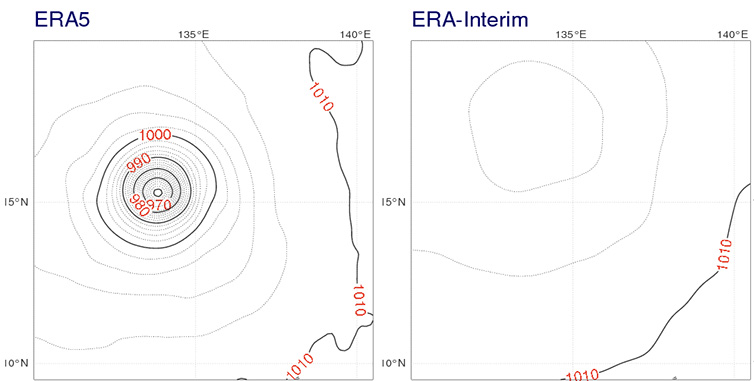
Dr Hans Hersbach, ECMWF C3S Reanalysis Team Leader
Within the Copernicus Climate Change Service (C3S), ECMWF is producing a detailed record of the evolution of the global atmosphere from 1950 onwards, using a method called reanalysis. This meteorological dataset, ERA5, provides estimates of atmospheric parameters such as air temperature, pressure, wind, humidity and ozone at different altitudes, surface parameters such as rainfall, soil moisture, sea-surface temperature, all at a resolution of about 31 km worldwide, and information on wave height over the global oceans. ERA5 will replace the ERA-Interim reanalysis, which is now 10 years old.
The new reanalysis could be used to monitor changes in the Earth’s temperature, for example, and to understand other aspects of weather and climate change. Users are likely to span a range of sectors including policy, commercial, research and education.
Recently the data for 2010–2016 was made publicly available. The other periods will follow in due course as well as updates of less than one week behind real time. In line with the C3S policy, all data are freely available.
In 2018, ERA5 will be available via the C3S Climate Data Store. This will include a toolbox that allows users to perform custom-made manipulations in the cloud to avoid the need for downloading large chunks of the huge dataset (about 9 petabytes in total).
What is reanalysis and why is it so popular?
Reanalysis combines model data with observations from across the world into a globally complete and consistent dataset using the laws of physics. This principle, called data assimilation, is based on the method used by numerical weather prediction centres, where every so many hours (12 hours at ECMWF) a previous forecast is combined with newly available observations in an optimal way to produce a new best estimate of the state of the atmosphere, called analysis, from which an updated, improved forecast is issued.
Reanalysis works in the same way, but at reduced resolution to allow for the provision of a dataset spanning back several decades. Reanalysis does not have the constraint of issuing timely forecasts, so there is more time to collect observations, and when going further back in time, to allow for the ingestion of improved versions of the original observations, which all benefit the quality of the reanalysis product.
The assimilation system is able to estimate biases between observations and to sift good-quality data from poor data. The laws of physics allow for estimates at locations where data coverage is low, such as for surface temperature in the Arctic. The provision of estimates at each grid point around the globe for each regular output time, over a long period, always using the same format, makes reanalysis a very convenient and popular dataset to work with.
Consistency is key
ECMWF has issued operational weather forecasts since 1979 and, like at any numerical weather prediction centre, the resolution and quality of the forecast system has improved dramatically over time, and as a result the representation of the analysed atmosphere has too.
With the lower resolution forecast model used back in 1979, certain weather phenomena were not well resolved and the model would incorrectly suggest lower extreme winds than now, for example. This is where reanalysis steps in. By using the same model and assimilation system throughout, the same processes are resolved in a consistent manner.
The observing system has also changed drastically over time, and although the assimilation system can resolve data holes, the initially much sparser networks will lead to less accurate estimates. For this reason, ERA5 includes an uncertainty estimate that provides guidance on where products are more/less accurate.
From the weather on the day that you were born to climate monitoring
Usage of reanalysis ranges from the study of particular historical cases, to the assessment of the long-term warming of the atmosphere and statistics of adverse weather events. Detailed knowledge of the changing climate during the past 7 decades is important and the timely updates of reanalysis allow for an accurate monitoring of the current state of the climate. Reanalysis data is used by public services, companies, universities and organisations. It features in numerous scientific studies and commercial applications.
One global snapshot each hour from 1950
Although the analysis procedure considers chunks of data in a window of 12 hours in one go, ERA5 provides estimates for each hour of the day, worldwide. This is made possible by the 4D-Var assimilation method, which takes account of the exact timing of the observations and model evolution within the assimilation window. This hourly output resolution is quite an improvement with respect to ERA-Interim, and provides a more detailed evolution of particular weather events. In addition, it allows users to carry out a much more accurate comparison with data from their specific applications.
What else is new in ERA5?
ERA5 benefits from a decade of research and development and the latest technologies that ERA-Interim did not incorporate.
ERA5 also benefits from CMIP5 radiative forcing, a consistent historical set for sea-surface temperature and sea-ice cover and other improved datasets.
Results show improved global hydrological and mass balance, reduced biases in precipitation, and refinement of the variability and trends of surface air temperature. The enhanced spatial and temporal resolution enables ERA5 to improve on ERA-Interim for many synoptic situations. One example is the dramatic improvement in the representation of Typhoon Halong which occurred in the West Pacific on 3 August 2014 (Figure 2).
ERA5 and the Copernicus Climate Change Service
Copernicus is the European Commission’s flagship Earth observation programme. It delivers freely accessible operational data and information services which provide users with reliable and up-to-date information related to environmental and security issues. Besides C3S, ECMWF also operates the Copernicus Atmosphere Monitoring Service (CAMS).
Together with the provision of seasonal forecasts, ERA5 forms the main scientific contribution from ECMWF to C3S.
Acknowledgments
Reanalysis covers many aspects and receives expert help from many across all departments at ECMWF. In particular, I would like to thank my team members, and also Dick Dee and Adrian Simmons.
Further information
ERA5 is the fifth state-of-the-art reanalysis at ECMWF, following the pioneering FGGE system (1979), ERA-15 (1994), ERA-40 (2001) and ERA-Interim (2006).
More reanalysis products have been produced at ECMWF, and other reanalysis activities take place at several places around the world. An overview can be found at reanalyses.org.
![]()
Figure 1: The principle of data assimilation in climate reanalysis.

Figure 2: Improved representation of Typhoon Halong on 3 August 2014 00 UTC by ERA5 (left panel) and ERA-Interim (right panel). Contour lines are 2 hPa.
